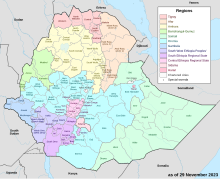Misraqawi Zone
Demographics

Based on the 2007 Census conducted by the Central Statistical Agency of Ethiopia (CSA), this Zone has a total population of 755,343, of whom 359,638 are men and 395,705 women; 146,064 or 19.34% are urban inhabitants. Two largest ethnic groups reported in the Eastern Zone were the Tigray (95.32%) and Irob (3.78%); all other ethnic groups made up 0.9% of the population. Tigrinya is spoken as a first language by 95.36% and Saho language by 3.67%; the remaining 0.97% spoke all other primary languages reported. 95.73% of the population said they were Orthodox Christians, 2.4% were Muslim, and 1.79% were Catholics.
In the 1994 Census, zone's population was 584,946, of whom 280,679 were males and 304,267 females; 85,508 or 14.6% of its population were urban dwellers. The Zone is predominantly Tigrayan, at 94.9% of the population, while 3.6% were Saho 0.9% were Afar, 0.3% Eritrean, and all other ethnic groups 0.2%.
According to a May 24, 2004 World Bank memorandum, 9% of the inhabitants of the zone have access to electricity, and has a road density of 88.2 kilometers per 1000 square kilometers, the average rural household has 0.5 hectare of land (compared to the national average of 1.01 hectare of land and a regional average of 0.51) and the equivalent of 0.7 heads of livestock. 38.9% of the population is in non-farm related jobs, compared to the national average of 25% and a regional average of 28%. 91% of all eligible children are enrolled in primary school, and 35% in secondary schools. It is not known how much of the zone is exposed to malaria, but none is exposed to the tsetse fly. The memorandum gave this zone a drought risk rating of 573.
References
- ^ Geohive: Ethiopia Archived 2012-08-05 at the Wayback Machine
- ^ Census 2007 Tables: Tigray Region Archived 2010-11-14 at the Wayback Machine, Tables 2.1, 3.1, 3.2, 3.4.
- ^ The 1994 Population and Housing Census of Ethiopia: Tigray Region Archived 2008-12-07 at the Wayback Machine, vol. 1, part 1: Tables 2.1 and 2.11
- ^ Comparative national and regional figures comes from another World Bank publication, Klaus Deininger et al. "Tenure Security and Land Related Investment", WP-2991 Archived 2007-03-10 at the Wayback Machine (accessed 23 March 2006).
- ^ World Bank, Four Ethiopias: A Regional Characterization (accessed 23 March 2006).